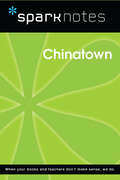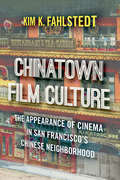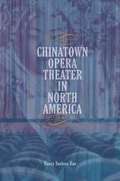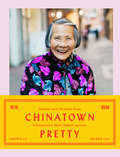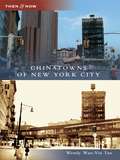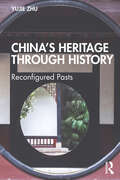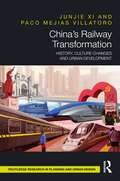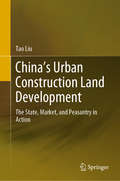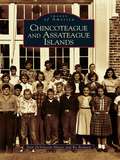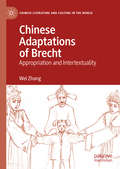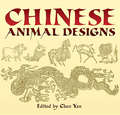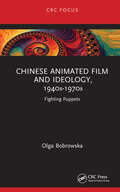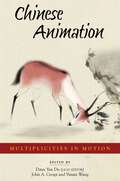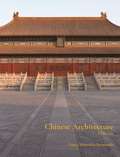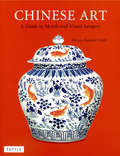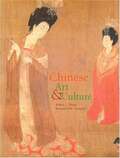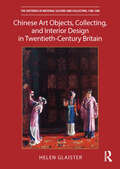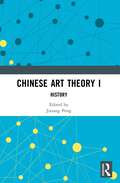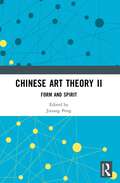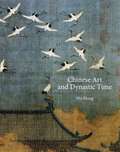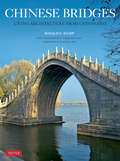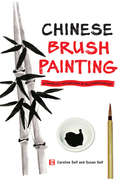- Table View
- List View
Chinatown (SparkNotes Film Guide)
by SparkNotesChinatown (SparkNotes Film Guide) Making the reading experience fun! SparkNotes Film Guides are one-stop guides to great works of film–masterpieces that are the foundations of filmmaking and film studies. Inside each guide you&’ll find thorough, insightful overviews of films from a variety of genres, styles, and time periods. Each film guide contains:Information about the director and the context in which the film was made Thoughtful analysis of major characters Details about themes, motifs, and symbols Explanations of the most important lines of dialogue In-depth discussions about what makes a film so remarkable SparkNotes Film Guides are an invaluable resource for students or anyone who wants to gain a deeper understanding of the great films they know and love.
Chinatown Film Culture: The Appearance of Cinema in San Francisco’s Chinese Neighborhood
by Kim K. FahlstedtChinatown Film Culture provides the first comprehensive account of the emergence of film and moviegoing in the transpacific hub of San Francisco in the early twentieth century. Working with materials previously left in the margins of grand narratives of history, Kim K. Fahlstedt uncovers the complexity of a local entertainment culture that offered spaces where marginalized Chinese Americans experienced and participated in local iterations of modernity. At the same time, this space also fostered a powerful Orientalist aesthetic that would eventually be exported to Hollywood by San Francisco showmen such as Sid Grauman. Instead of primarily focusing on the screen-spectator relationship, Fahlstedt suggests that immigrant audiences' role in the proliferation of cinema as public entertainment in the United States saturated the whole moviegoing experience, from outside on the street to inside the movie theater. By highlighting San Francisco and Chinatown as featured participants rather than bit players, Chinatown Film Culture provides an historical account from the margins, alternative to the more dominant narratives of U.S. film history.
Chinatown Opera Theater in North America
by Nancy Yunhwa RaoThe Chinatown opera house provided Chinese immigrants with an essential source of entertainment during the pre “World War II era. But its stories of loyalty, obligation, passion, and duty also attracted diverse patrons into Chinese American communities Drawing on a wealth of new Chinese- and English-language research, Nancy Yunhwa Rao tells the story of iconic theater companies and the networks and migrations that made Chinese opera a part of North American cultures. Rao unmasks a backstage world of performers, performance, and repertoire and sets readers in the spellbound audiences beyond the footlights. But she also braids a captivating and complex history from elements outside the opera house walls: the impact of government immigration policy; how a theater influenced a Chinatown's sense of cultural self; the dissemination of Chinese opera music via recording and print materials; and the role of Chinese American business in sustaining theatrical institutions. The result is a work that strips the veneer of exoticism from Chinese opera, placing it firmly within the bounds of American music and a profoundly American experience.
Chinatown Pretty: Fashion and Wisdom from Chinatown's Most Stylish Seniors
by Valerie Luu Andria LoChinatown Pretty features beautiful portraits and heartwarming stories of trend-setting seniors across six Chinatowns.Andria Lo and Valerie Luu have been interviewing and photographing Chinatown's most fashionable elders on their blog and Instagram, Chinatown Pretty, since 2014.Chinatown Pretty is a signature style worn by pòh pohs (grandmas) and gùng gungs (grandpas) everywhere—but it's also a life philosophy, mixing resourcefulness, creativity, and a knack for finding joy even in difficult circumstances.• Photos span Chinatowns in San Francisco, Oakland, Los Angeles, Chicago, New York City, and Vancouver.• The style is a mix of modern and vintage, high and low, handmade and store bought clothing.• This is a celebration of Chinese American culture, active old-age, and creative style.Chinatown Pretty shares nuggets of philosophical wisdom and personal stories about immigration and Chinese-American culture.This book is great for anyone looking for advice on how to live to a ripe old age with grace and good humor—and, of course, on how to stay stylish.• This book will resonate with photography buffs, fashionistas, and Asian Americans of all ages.• Chinatown Pretty has been featured by Vogue.com, San Francisco Chronicle, Design Sponge, Rookie, Refinery29, and others.• With a textured cover and glossy bellyband, this beautiful volume makes a deluxe gift.• Add it to the shelf with books like Humans of New York by Brandon Stanton, Advanced Style by Ari Seth Cohen, and Fruits by Shoichi Aoki.
Chinatowns of New York City
by Wendy Wan-Yin TanFor a span of more than a century, New York's Chinese communities have grown uninterruptedly from three streets in lower Manhattan to five Chinatowns, over 100 street blocks, across the boroughs of Manhattan, Queens, and Brooklyn. No other Chinese communities outside Asia come close to this magnitude.
China’s Heritage through History: Reconfigured Pasts
by Yujie ZhuChina’s Heritage through History employs a longue durée approach to examine China’s heritage through history. From Imperial to contemporary China, it explores the role of practices and material forms of the past in shaping social transformation through knowledge production and transmission.The art of collecting, reproducing, and reinterpreting the past has been an enduring force shaping cultural identity and political legitimacy in China. Offering a unique, non-Western perspective on the history of heritage in China, Zhu considers who the key players have been in these ongoing processes of reconfigured pasts, what methods they have employed, and how these practices have shaped society at large. The book tackles these questions by delving into the transformation of practices related to heritage through examples such as the book collection at Tianyi Private Library, the reproduction of the Orchid Pavilion Preface calligraphy and its associated sites, and the dynamics of exchange within the Liulichang antique market. Zhu reveals how these practices, once reserved for elites, have become accessible to the broader public. These processes of transformation, embodied in various forms of reconfigured pasts, have given rise to modern approaches to preservation, digitisation, museums, and the burgeoning heritage tourism industry.China’s Heritage through History will be an invaluable resource for academics, students, and practitioners working in the fields of heritage, museum studies, and art history.
China’s Railway Transformation: History, Culture Changes and Urban Development
by Junjie Xi Paco Mejias VillatoroThis book investigates China’s railway transformation through history, along with culture changes and urban development. The book begins by looking at the background of China and the history and growth of railway development in China through five key phases, followed by assessing the cultural changes in the railway carriage and exploring how these are linked to social equality and national provisions. The core of this book aims to analyse the Chinese urban transformation through the development of the high-speed rail (HSR) infrastructure in China. Eleven important new HSR stations in mainland China, plus the new Hong Kong West Kowloon Station, have been selected to contextually explore how HSR infrastructures have affected the development of the Chinese urban context. The selected case studies are the stations of Beijing South, Wuhan, Shanghai Hongqiao, Guangzhou South, Xi’an North, Nanjing South, Chengdu East, Tianjin West, Zhengzhou East, Hangzhou East and Hong Kong West Kowloon. All of these were built between 2008 and 2018. In these case studies, the location and the intentions and success of promoting urban development are analysed and assessed. Following this, the book further investigates the peculiarities of the new HSR stations in China in comparison with stations in Europe. An assessment framework is established to evaluate the Chinese case studies comparatively with significant cases in Europe, attending to the urban structure of the area, the architectural quality, the functional diversity and the quality of the public space generated in the surrounding area.
China’s Urban Construction Land Development: The State, Market, and Peasantry in Action
by Tao LiuThis book examines the nature and internal dynamics of China’s urban construction land (UCL) development, drawing insights from the recently developed theory of regional political ecology. Based on the author’s original research, it identifies two different types of UCL development in China, namely top-down, formal development in the legal and regulated domain, and spontaneous and informal, bottom-up development in the semi-legal, poorly regulated gray domain. Presenting a systematic analysis and comparison, it reveals a scale and speed of informal land development no less significant than that of formal land development, although informal land development tends to be scattered, pervasive, difficult to track, and largely overlooked in research and policy formation. Contrary to the popular perception of the peasantry as passive victims of land development, this book uncovers an intriguing dynamic in which the peasantry has played an increasingly (pro)active role in developing their rural land for urban uses in informal markets. Further, based on an investigation of UCL development in Beijing and Shenzhen, it shows an interesting trajectory in which the uneven growth and utilization of UCL are contingent upon the various developmental milieus in different places. China’s land institutions, based on an urban–rural dual land system, are not conducive to the ultimate goal of saving and efficiently utilizing land. Accordingly, an urban–rural integrated land market and management system is highly advisable. The theoretical and empirical enquiry presented challenges the perceived notion of China’s UCL development as the outcome of market demand and state supply. Further, it argues for an inclusive treatment of the informality that has characterized urbanization in many developing countries, and for a reassessment of the role played by the peasantry in land-based urbanization.
Chincoteague and Assateague Islands (Images of America)
by Bo Bennett Nan Devincent-HayesThe thriving barrier islands of Chincoteague and Assateague entice over a million tourists to their shores every year. Adjacent to one another, these parcels of land jutting into the Atlantic have a symbiotic relationship--Chincoteague, a modern, developed community that thrives on tourism, helps attract visitors to neighboring Assateague, which in turn acts as a natural buffer against the surging tides and is home to Assateague Island NationalSeashore, a state park that provides protection for native flora and fauna and leisure activities for the nature lover. Overlapping the border between Maryland and Virginia, Assateague Island remains an undisturbed natural habitat boasting extensive wetlands and wildlife. Images of the native inhabitants of this area abound--the ponies, birds, and sea life take center stage, while the sandy dunes and rolling ocean provide a beautiful backdrop. The families who made the island of Chincoteague their home, from as early as 1650, were a tough breed and, over the years, made many contributions to the improvement of their community. Schools, churches, and businesses were established,bridges were built, roads were paved, and waterways made navigable--all of this visually documented and now available in this remarkable volume.
Chinese Adaptations of Brecht: Appropriation and Intertextuality (Chinese Literature and Culture in the World)
by Wei ZhangThis book examines the two-way impacts between Brecht and Chinese culture and drama/theatre, focusing on Chinese theatrical productions since the end of the Cultural Revolution all the way to the first decades of the twenty-first century. Wei Zhang considers how Brecht’s plays have been adapted/appropriated by Chinese theatre artists to speak to the sociopolitical, economic, and cultural developments in China and how such endeavors reflect and result from dynamic interactions between Chinese philosophy, ethics, and aesthetics, especially as embodied in traditional xiqu and the Brechtian concepts of estrangement (Verfremdungseffekt) and political theatre. In examining these Brecht adaptations, Zhang offers an interdisciplinary study that contributes to the fields of comparative drama/theatre studies, intercultural studies, and performance studies.
Chinese Animal Designs
by Chen YanCompiled by a Chinese authority on the subject, this superb archive contains more than 1,100 illustrations of animals, grouped chronologically according to dynastic era--from dragon designs of the Shang and Chou dynasties (ca. 2030 B.C. to 221 B.C.) to delicate images of butterflies by twentieth century artists. Additional motifs depict such figures as the phoenix, bird, tiger, and horse from the Han period, a variety of quadrupeds and fish from the Ming and Sung dynasties, and modern era motifs depicting lions, cats, pigs, water fowl, and insects.Easily adaptable by commercial artists and graphic designers for use as spot illustrations, borders, and other graphic elements, these exotic images will add a distinctive Far Eastern accent to a variety of art and craft projects.
Chinese Animated Film and Ideology, 1940s-1970s: Fighting Puppets (Focus Animation Ser.)
by Olga BobrowskaThis book examines animated propaganda produced in mainland China from the 1940s to the 1970s. The analyses of four puppet films demonstrate how animation and Maoist doctrine became tightly but dynamically entangled. The book firstly contextualizes the production conditions and ideological contents of The Emperor’s Dream (1947), the first puppet film made at the Northeast Film Studio in Changchun. It then examines the artistic, intellectual, and ideological backbone of the puppet film Wanderings of Sanmao (1958). The book presents the means and methods applied in puppet animation filmmaking that complied with the ideological principles established by the radical supporters of Mao Zedong in the first half of the 1960s, discussing Rooster Crows at Midnight (1964). The final chapter discusses The Little 8th Route Army (1973), created by You Lei in the midst of the Cultural Revolution. This book will be of great interest to those in the fields of animation studies, film studies, political science, Chinese area studies, and Chinese philology.
Chinese Animation: Multiplicities in Motion (Harvard East Asian Monographs #475)
by Daisy Yan DU, John A. CRESPI, Yiman WANGChinese Animation: Multiplicities in Motion is the first edited volume that explores the multiple histories, geographies, industries, technologies, media, and transmedialities of Chinese animation, from early animated special effects to socialist classics, from computer-generated-imagery (CGI) blockbusters to edgy independent films, and from stop-motion to virtual reality.Its fifteen chapters, grouped under the five themes of junctures, gender, identities, digitality, and practices, span a century of animation since the 1920s across mainland China, Hong Kong, Taiwan, Singapore, and the diasporic world. Derived from the 2021 Inaugural Conference of the Association for Chinese Animation Studies (ACAS), this volume as a whole defines Chinese animation studies as a new field of research emerging from the peripheries of modern Chinese literature and film studies on the one hand, and from the margins of Western and Japanese animation studies on the other. Incorporating diverse academic approaches and perspectives, this groundbreaking book is an indispensable guide for a rapidly growing community of scholars, students, animators, fans, and general readers interested in Chinese and world animation.
Chinese Architecture: A History (The\culture And Civilization Of China Ser.)
by Nancy SteinhardtAn unprecedented survey of the origins and evolution of Chinese architecture, from the last millennia BCE to todayThroughout history, China has maintained one of the world’s richest built civilizations. The nation’s architectural achievements range from its earliest walled cities and the First Emperor’s vision of city and empire, to bridges, pagodas, and the twentieth-century constructions of the Socialist state. In this beautifully illustrated book, Nancy Shatzman Steinhardt presents the first fully comprehensive survey of Chinese architecture in any language. With rich political and historical context, Steinhardt covers forty centuries of architecture, from the genesis of Chinese building through to the twenty-first century and the challenges of urban expansion and globalism.Steinhardt follows the extraordinary breadth of China’s architectural legacy—including excavation sites, gardens, guild halls, and relief sculpture—and considers the influence of Chinese architecture on Japan, Korea, Mongolia, and Tibet. Architectural examples from Chinese ethnic populations and various religions are examined, such as monasteries, mosques, observatories, and tombs. Steinhardt also shows that Chinese architecture is united by a standardized system of construction, applicable whether buildings are temples, imperial palaces, or shrines. Every architectural type is based on the models that came before it, and principles established centuries earlier dictate building practices. China’s unique system has allowed its built environment to stand as a profound symbol of Chinese culture.With unprecedented breadth united by a continuous chronological narrative, Chinese Architecture offers the best scholarship available on this remarkable subject for scholars, students, and general readers.
Chinese Art
by Patricia Bjaaland WelchChinese Art is a guide to the meanings behind the hundreds of common motifs and symbols found in all forms of Chinese art. A thorough examination of the diverse usage of natural symbols, colors, numbers, inanimate items and personages, Chinese Art communicates the deeper messages to be found in Chinese decorative art. It is an excellent reference for collectors, museum-goers and students of Chinese art, culture and history.
Chinese Art
by Patricia Bjaaland WelchChinese Art is a guide to the meanings behind the hundreds of common motifs and symbols found in all forms of Chinese art. A thorough examination of the diverse usage of natural symbols, colors, numbers, inanimate items and personages, Chinese Art communicates the deeper messages to be found in Chinese decorative art. It is an excellent reference for collectors, museum-goers and students of Chinese art, culture and history.
Chinese Art And Culture
by Robert L. Thorp Richard Ellis VinogradLucid, authoritative, written with verve by two respected American scholars, this generously illustrated work provides an introduction to more than 7,000 years of Chinese art -- from the pottery-making and jade-carving cultures of the Neolithic Age to contemporary Chinese artists working in video, installation, and performance media.By placing the arts in context -- in active engagement with societies, economies, and wider fields of culture -- the authors of this much-needed general survey introduce a dynamic and continually evolving tradition rather than a sequence of isolated museum masterpieces. Although the story of Chinese art unfolds chronologically, the authors introduce relevant themes for each era that will deepen the reader's understanding of and appreciation for what they describe as arguably "the most abundantly productive, continuous artistic culture in the history of the world".
Chinese Art Objects, Collecting, and Interior Design in Twentieth-Century Britain (The Histories of Material Culture and Collecting, 1700-1950)
by Helen GlaisterThis book explores the relationship between collecting Chinese ceramics, interior design and display in Britain through the eyes of collectors, designers and taste makers during the years leading to, during and following World War II. The Ionides Collection of European Style Chinese Export Porcelain forms the nucleus of this study – defined by its design hybridity – offering insights into the agency of Chinese porcelain in diverse contexts, from seventeenth century Batavia to twentieth century Britain, raising questions about notions of Chineseness, Britishness and identity politics across time and space. Through the biographies of the collectors, this book highlights the role of collecting Chinese art objects, particularly porcelain, in the construction of individual and group identities. Social networks linking the Ionides to agents and dealers, auctioneers and museum specialists bring into focus the dynamics of collecting during this period, the taste of the Ionides and their self-fashioning as collectors. The book will be of interest to scholars working in the fields of art history, history of collections, interior design, Chinese studies, and material culture studies.
Chinese Art Theory I: History
by Jixiang PengAs the first volume of a two-volume set on traditional Chinese art, this book outlines the history of Chinese art spanning several millennia.The first volume provides a panoramic view of Chinese traditional art history by highlighting key art forms from different historical periods. It covers ancient tattoos, clothing, masks, pottery, and bronzeware, as well as the art of the Tang, Yuan, Ming, and Qing dynasties.This title is a valuable read for students and scholars of art, especially Chinese art theory and history. It will also attract those interested in the philosophical and aesthetic foundations of traditional Chinese art.
Chinese Art Theory II: Form and Spirit
by Peng JixiangAs the second volume of a two-volume set on Chinese art theory, this book introduces the typology of Chinese art and expands on the aesthetic and artistic theories of Chinese traditional art.The first part of this volume introduces representative genres of Chinese traditional art, including literary works, painting, and calligraphy. It covers scholar-artist art, folk art, palace art, and religious art at various levels and dimensions. The book demonstrates how Chinese traditional art uniquely embodies the nation's aesthetic sensibility, while reflecting its distinctive national traits in both creation and appreciation. The second part distills these theories to identify the fundamental principles and aesthetic characteristics that best represent the artistic spirit of Chinese tradition. Throughout, this book illustrates how traditional Chinese art reflects the cultural mindset and aesthetic consciousness of its people.This book is a valuable read for students and scholars of art studies, especially Chinese art theory and history. It will also appeal to anyone interested in the philosophical and aesthetic foundations of Chinese traditional art.
Chinese Art and Dynastic Time (The A. W. Mellon Lectures in the Fine Arts #48)
by Wu HungA sweeping look at Chinese art across the millennia that upends traditional perspectives and offers new pathways for art historyThroughout Chinese history, dynastic time—the organization of history through the lens of successive dynasties—has been the dominant mode of narrating the story of Chinese art, even though there has been little examination of this concept in discourse and practice until now. Chinese Art and Dynastic Time uncovers how the development of Chinese art was described in its original cultural, sociopolitical, and artistic contexts, and how these narratives were interwoven with contemporaneous artistic creation. In doing so, leading art historian Wu Hung opens up new pathways for the consideration of not only Chinese art, but also the whole of art history.Wu Hung brings together ten case studies, ranging from the third millennium BCE to the early twentieth century CE, and spanning ritual and religious art, painting, sculpture, the built environment, and popular art in order to examine the deep-rooted patterns in the historical conceptualization of Chinese art. Elucidating the changing notions of dynastic time in various contexts, he also challenges the preoccupation with this concept as the default mode in art historical writing. This critical investigation of dynastic time thus constitutes an essential foundation to pursue new narrative and interpretative frameworks in thinking about art history.Remarkable for the sweep and scope of its arguments and lucid style, Chinese Art and Dynastic Time probes the roots of the collective imagination in Chinese art and frees us from long-held perspectives on how this art should be understood.Published in association with the Center for Advanced Study in the Visual Arts, National Gallery of Art, Washington, DC
Chinese Bridges
by A. Chester Ong Ronald G. Knapp Peter BolBridges, the least known and understood of China's many wonders, are one of its most striking and resilient feats of architectural prowess. Chinese Bridges brings together a thorough look at these marvels from one of the world's leading experts on Chinese culture and historical geography, Ronald G. Knapp.While many consider bridges to be merely utilitarian, the bridges of China move beyond that stereotype, as many are undeniably dramatic, even majestic and daring. Chinese Bridges illustrates in detail 20 well-preserved ancient bridges, along with descriptions and essays on the distinctive architectural elements shared by the various designs. For the first time in an English-language book, Chinese Bridges records scores of newly discovered bridges across China's vast landscape, illustrated with over 400 color photographs, as well as woodblock prints, historic images, paintings and line drawings.
Chinese Bridges
by A. Chester Ong Ronald G. Knapp Peter BolBridges, the least known and understood of China's many wonders, are one of its most striking and resilient feats of architectural prowess. Chinese Bridges brings together a thorough look at these marvels from one of the world's leading experts on Chinese culture and historical geography, Ronald G. Knapp.While many consider bridges to be merely utilitarian, the bridges of China move beyond that stereotype, as many are undeniably dramatic, even majestic and daring. Chinese Bridges illustrates in detail 20 well-preserved ancient bridges, along with descriptions and essays on the distinctive architectural elements shared by the various designs. For the first time in an English-language book, Chinese Bridges records scores of newly discovered bridges across China's vast landscape, illustrated with over 400 color photographs, as well as woodblock prints, historic images, paintings and line drawings.
Chinese Brush Painting
by Caroline Self Susan SelfChinese ink painting is an offshoot of calligraphy and is a beautiful and reflective art that's been revered in China for centuries. A wonderfully creative tool, this book is an excellent way for newcomers to experience this ancient art form.Traditional black-and-white Chinese ink painting elements, along with the tradition's essentials--such as the quality and variety of the tools and accessories used in its practice are all covered. The Art of Chinese Brush Painting encourages readers to be mindful of the principles of composition and perspective, and introduces specific techniques for several different elements, including Chinese Zodiac animals and landscapes.
Chinese Brush Painting
by Caroline Self Susan SelfChinese ink painting is an offshoot of calligraphy and is a beautiful and reflective art that's been revered in China for centuries. A wonderfully creative tool, this book is an excellent way for newcomers to experience this ancient art form.Traditional black-and-white Chinese ink painting elements, along with the tradition's essentials--such as the quality and variety of the tools and accessories used in its practice are all covered. The Art of Chinese Brush Painting encourages readers to be mindful of the principles of composition and perspective, and introduces specific techniques for several different elements, including Chinese Zodiac animals and landscapes.
